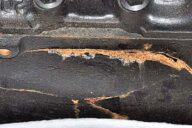Where do your Genoa sheet blocks need to be positioned along the Genoa track? It all starts with a neutral block position. Find the neutral block position where the sheet will apply equal tension on the leech and foot.
The neutral or “starting” sheet block position will give you a starting point for other sheet lead block settings. This position will depend on the relationship between the foot and leech of your Genoa or headsail. You want the Genoa or jib sheet to exert equal amounts of tension along the foot and leech for a good overall shape in moderate sailing conditions.
Most cruising Genoas are 150%, so the leech will be about 50% longer than the foot. Thinner sails like a working jib will need the sheet blocks positioned farther forward to support the longer leech (more on this later).

Find the neutral block position. This places equal tension along the leech and foot of the sail.
150% Genoa Neutral Block Position
Pick a day with little to no wind. No need to get underway, you can do this first part in your slip. Unfurl the Genoa or hank on one of your sails. Determine the mid-point of your sail luff. You could mark this with a small piece of removable tape or just estimate the mid-point of the luff by eye.
Bend down in line with the Genoa lead block on one side of the boat. Sight up the sheet to the mid-point of the luff.
Slide the block fore or aft to create an imaginary straight line from the lead block up the sheet through the clew and then to the mid-point of the luff (dotted line in the illustration to the right). Mark the track position with tape or a marker.
Mark the same position on the track on the other side of the boat. Keep both blocks in this neutral position in moderate sailing winds.
Working Jib Neutral Block Position
Thinner sails have longer leeches relative to the foot, so they need more tension along the leech. Sight up the sail to a point about 60% to 70% above the tack. Move the working jib block to this location along the working jib track. Set the block on the opposite side working jib track to this same position. Mark the neutral block position for the working jib on both sides of the boat.
How to Test Sheet Block Position
Test your block positions once you go sailing. Get onto a close hauled course with all luff telltales streaming together. Head up at a slow pace and watch the telltales break (flutter). Do they all break together from top to bottom? If they do, then you have the blocks just right.

If the top telltale breaks first, move the block forward (left illustration). If the bottom telltale breaks first, move the block back (right illustration).
If the upper telltales break first, your blocks are too far aft. This places more tension on the foot than the leech. Move the blocks a hole or two toward the bow (Top=Toward). Repeat the test; adjust as necessary until all telltales break even at the same time.
If the lower telltales break first, your blocks are too far forward. This places more tension on the leech than the foot. Move the blocks a hole or two back (Bottom=Back). Repeat the test; adjust as necessary until all telltales break at the same time.
~~~~~~~~~~~~~~~~~~~~
Captain John’s Sailing Tip
Take care not to set the blocks too far aft if your bottom telltale breaks first. Keep the leech under good control without too much twist. Watch your knot meter. Trim and check your speed. If your speed increased, you are good to go. If not, try something else. In the end, sail trim will always be about experimentation. Your boat will let you know what she likes.
~~~~~~~~~~~~~~~~~~~~













